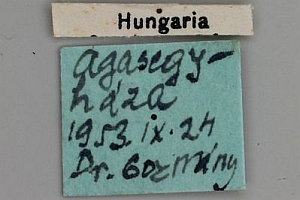

 +9Kontinente:EUAS
+9Kontinente:EUAS1. Lebendfotos
1.1. Falter
2. Diagnose
2.1. Geschlecht nicht bestimmt
2.2. Erstbeschreibung
3. Biologie
3.1. Habitat
3.2. Nahrung der Raupe
- [Asteraceae:] Chondrilla juncea (Knorpelsalat)
Fazekas & Lesar (2009: 197) schreiben: "Larva (IV–V) monophagous on Chondrilla juncea L. According to authors (Kuznetzov 1994, Razowski 2002) older larvae may be reared on salad and some Asteraceae. Pupation in feeding place where larvae aestivate; hibernation in egg stage. Univoltine species, the moths flying from late August to early October."
4. Weitere Informationen
4.1. Andere Kombinationen
- Cnephasia wertheimsteini Rebel, 1913 [Originalkombination]
4.2. Synonyme
- Oxypteron amseli Razowski, 1957
4.3. Faunistik
Fazekas & Lesar (2009: 197) nennen Vorkommen in Ungarn, in Slowenien und in der Slowakei. Nach der [Fauna Europaea] und andeen Quellen kommt die Art außerdem in Rumänien, in der Ukraine und im Süden des europäischen Teils von Russland vor. Fazekas & Lesar (2009: 197) formulieren: "Widely distributed from Iran, central Asia, Asia Minor and to Balkans, and in favourable localities in Hungary, Slovakia and Slovenia." Typenfundort ist Csételek [Cséhtelek, RO-Ciutelec] in Rumänien.
(autor: Erwin Rennwald)
4.4. Literatur
- Fazekas, I. & T. Lesar (2009): Distribution of Oporopsamma wertheimsteini (Rebel, 1913) in Central Europe (Lepidoptera: Tortricidae). — Natura Somogyensis 15: 195-202. [zum PDF auf researchgate.net]
- Erstbeschreibung: Rothschild, N. C. (1913): Adatok Magyarország lepkefaunájához. V. (Beiträge zur Lepidopterenfauna Ungarns). — Rovartani lapok 20: 66-91, pl. II.

























